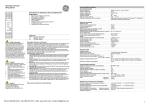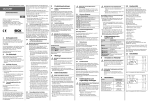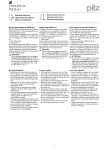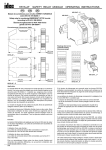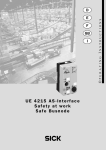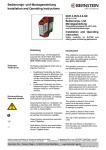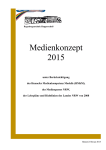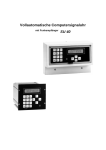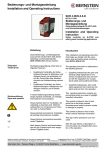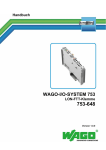Download XPS-ABV - Schneider Electric
Transcript
XPS-ABV www.schneider-electric.com FR EN DE Module de surveillance pour circuits d'ARRET D'URGENCE et Applications Verrouillage de Protecteur selon EN / IEC 60204-1, EN ISO / ISO 13849-1, EN ISO / ISO 13850 (Traduction de l’instruction de service originale) Safety Relay for monitoring EMERGENCY STOP circuits and Protective Guard Applications according to EN / IEC 60204-1, EN ISO / ISO 13849-1, EN ISO / ISO 13850 XPS-ABV....P (Translation of the original instruction sheet) Überwachungsbaustein für Not-Halt Kreise und Schutztür-Anwendungen gemäß EN / IEC 60204-1, EN ISO / ISO 13849-1, EN ISO / ISO 13850 (Originalbetriebsanleitung) 35 mm (1.38 in) 99 mm (3.89 in) Encombrements / Dimensions / Maße XPS-ABV....C ➁ ➀ 22,5 mm (0.89 in) 114 mm (4.48 in) XPS-ABV....P 35 mm 114 mm (4.48 in) XPS-ABV....P XPS-ABV....C 13 23 24 37 A1 S33 S34 S35 13 23 24 37 A1 S33 S34 S35 (1.38 in) 111 mm (4.37 in) Repérage des bornes / Terminal marking / Klemmenanzeiger 22,5 mm (0.89 in) XPS-ABV....C XPSABV XPSABV SUPPLY SUPPLY K1/ K2 K1/ K2 K3/ K4 S S S21 S22 S31 A2 14 S11 S12 38 24 375 13 233 S34 S3 A1 S3 XPSABV 24 375 13 233 S34 S3 A1 S3 XPSABV SUPP K1/ K2 LY K1/ K2 LY K3/ K4 1,5 1 2 K3/ K4 2,5 0,5 0,3 0,15 1,5 1 SUPP 24V c Note / Note / Hinweis: Temporisation de retombée (K3, K4) réglables / Off-delay time (K3, K4) adjustable / Rückfallverzögerungszeit (K3, K4) einstellbar, XPSABV1133• : XPSABV11330• : 0,3 0,15 2,5 3 S 3 24V c S A2 2 S31 S21 S21 S12 38 14 S1 A2 2 S31 S21 S21 S12 38 14 S1 XPS-ABV....P BBV61412.00 12 - 04 - 2010 1 / 12 S21 S22 S31 A2 14 S11 S12 38 0,15 … 3 s 1,5 … 30 s 2 0,5 XPS-ABV....C K3/ K4 Vue de face / Front View / Frontansicht SUPPLY LED verte / green / grün K1,K2 LED verte / green / grün K3, K4 LED verte / green / grün XPS-ABV FRANÇAIS DANGER TENSION DANGEREUSE Le montage, la mise en service, les modifications et le rééquipement ne doivent être effectués que par un électrotechnicien ! Débranchez l’appareil / le système avant de commencer les travaux ! Dans le cas d’une défaillance de l’installation ou du système, les appareils du circuit de commande sans isolation électrique peuvent être sous tension réseau ! Lors de l’installation des appareils, respectez les réglementations de sécurité pour usage électrique et de la caisse de prévoyance contre les accidents. L’ouverture du boîtier ou toute autre manipulation entraîne l’expiration de la garantie. Le non-respect de cette directive entraînera la mort, des blessures graves ou des dommages matériels. ATTENTION UTILISATION INAPPROPRIÉE En cas d'usage non approprié ou d'utilisation non conforme, l'appareil ne peut plus être utilisé et nous refusons tout recours à la garantie. Des actions non autorisées peuvent être: forte charge mécanique de l'appareil, qui survient par ex. lorsqu'il tombe, ainsi que tensions, courants, températures et humidité en dehors des limites définies dans les spécifications. Lors de la première mise en service de la machine/de l'installation, veuillez contrôler toujours toutes les fonctions de sécurité conformément aux prescriptions en vigueur et respecter les cycles de contrôle prescrits pour les dispositifs de sécurité. Le non-respect de cette directive peut entraîner des lésions corporelles et/ou des dommages matériels. ATTENTION DANGER Á L´INSTALLATION Respectez le mesures de sécurité suivantes avant l’installation / le montage ou le démontage : 1. Débranchez l’appareil / le système avant de commencer les travaux ! 2. Protégez la machine / le système contre les redémarrages intempestifs ! 3. Assurez-vous que la machine est hors tension ! 4. Reliez les phases à la terre et court-circuitezles ! 5. Couvrez et isolez les pièces voisines sous tension ! 6. Le montage des appareils doit être effectué dans une armoire électrique avec une classe de protection min. IP 54. Le non-respect de cette directive peut entraîner des lésions corporelles et/ou des dommages matériels. ATTENTION PROTECTION PARTIELLE CONTRE LES CONTACTS ACCIDENTELS • Classe de protection selon EN/IEC 60529. • Boîtier / bornes : IP 40 / IP 20. Module de surveillance pour circuits d'ARRET D'URGENCE et Applications Verrouillage de Protecteur • Module de surveillance conformément à EN / IEC 60204-1 et EN ISO / ISO 13850 pour le contrôle de l’arrêt d’urgence et Applications Verrouillage de Protecteur. • Pour catégorie d’arrêt 0 selon EN / IEC 60204-1: - PL e / Catégorie 4 - MTTFd = 53 Années - PFHd > 3 x 10-8 1/h - SILCL 3 • Pour catégorie d’arrêt 1 selon EN / IEC 60204-1: - PL e / Catégorie 3 - MTTFd = 53 Années - PFHd = 2 x 10-7 1/h - SILCL 2 • Contrôle monocanal ou à deux canaux par contacts ou semiconducteur appropriée. • Boucle de retour pour le contrôle des contacteurs externes • Détection de courts-circuits • 3 contacts de sécurité (2 NO instantanés, 1 NO temporisé à la retombée) Description de l´appareil a Description fonctionelle Après mise sous tension du module, arrêt d'urgence déverrouillé, une impulsion sur le BP de validation déclenche le cycle d'auto-contrôle et de mise en route. Les relais internes K1 à K4 montent et s'auto-maintiennent par leurs contacts auxiliaires. Les contacts de sécurités sont alors fermés (bornes 13/14, 23/24 et 37/38). 3 LEDs signalent l'état 2 canaux de sécurité K1/K2 et K3/K4, et la présence tension. Si l'arrêt d'urgence est actionné (ouverture des contacts du BP), l'alimentation des relais internes K1 et K2 est coupée. Les deux contacts de sécurité instantanés s'ouvrent immédiatement (temps de retombée tR1) et le contact de sécurité temporisé reste fermé. Après écoulement de la temporisation paramétrée (tR2), K3 et K4 retombent et le contact 37/38 s'ouvre. La temporisation de retombée est réglable. Un câblage approprié en deux canaux (BP d'AU ou IDP capot) permet de détecter les défauts de courts-circuits et de mise à la masse. Le relais de sécurité est protégé par un fusible électronique. Après disparition du défaut, le module est prêt à fonctionner après environ 3 s. Surveillance du poussoir de validation Le module permet de contrôler un éventuel dysfonctionnement (collage, masse) du BP de validation. Le réarmement peut en effet être déclenché sur un front descendant du BP (borne S34) ou sur un front montant (borne S35). En mode réarmement manuel, le BP de validation doit être câblé entre S33/S34. Le réarmement est alors déclenché sur le front descendant. Ceci permet de contrôler une fermeture puis une ouverture du BP (contrôle dynamique du BP). Pour les applications de contrôle de capot mobile, le réarmement automatique du module est souvent requis. Un shunt entre S33/S35 est alors nécessaire. Le module se réarme si le circuit est fermé (connexion interne réalisée entre S33 et S12 pour obtenir un front montant). Contrôle de désynchronisme Sur certaines installations ou machines, le contrôle des capots mobiles est réalisé par deux IDP (zones dangereuses à accès fréquent). Le module de sécurité est alors câblé en deux canaux. Dans ce cas, le module permet de contrôler ou non le temps de désynchronisme entre la fermeture des canaux. Si le canal 1 (S11/S12) se ferme avant le canal 2 (S21/S22), le désynchronisme maxi. autorisé est tS ≈0,5 s. Si le canal 2 se ferme avant le canal 1, il n'y a plus de contrôle de désynchronisme tS = ∞ . Attention: le contrôle du désynchronisme augmente la sécurité du système et rend la fraude plus difficile. Usage conforme Les appareils sont des relais de sécurité. Ils doivent uniquement être utilisés comme composants de dispositifs de protection sur les machines, en vue de protéger l'homme, le matériel et la machine. • Protection des doigts selon EN 50274. Le non-respect de cette directive peut entraîner des lésions corporelles et/ou des dommages matériels. 2 / 12 XPS-ABV Note: • Le niveau de performance et la catégorie de sécurité selon la norme EN ISO / ISO 13849-1 dépendent du câblage extérieur, du cas d’application, du choix de l’émetteur d’ordres et de l’agencement sur la machine sur place. • L’utilisateur doit effectuer une évaluation du risque conformément à la norme EN ISO / ISO 14121-1. • Il convient de réaliser sur cette base une validation de l’ensemble de l’installation / de la machine selon les normes applicables. • Le module contient des relais électromécaniques. Par conséquent sa valeur MTTFd dépend de la charge et de la fréquence de manoeuvre dans le cas d’utilisation. La valeur MTTFd en année mentionnée ci-dessus a été déterminé en admettant une valeur B10d pour charge maximale de 400.000 et un nombre moyen de manoeuvres nop = 8760 cycles / an ( cf. EN ISO / ISO 13849-1, C.2.4 et Tab. K.1). • Le niveau de performance indiqué est uniquement garantit, tant que le nombre de manoeuvres et les charges mentionnés ne sont pas dépassés. Après atteinte de ces limites, l'appareil doit être remplacé, cependant au plus tard après une durée d'utilisation maximale de 20 ans. • Lorsque la charge électrique est connue, le diagramme de durée de vie électrique (voir pages 9/12) doit être utilisé pour calculer le nombre de manœuvres maximum. • L’utilisation de l’appareil non conforme aux spécifications peut provoquer des dysfonctionnements ou la destruction de l’appareil. • En principe, lors de l’utilisation de l’appareil, les temps indiqués doivent être respectés, leur non-respect pouvant mener au verrouillage de l’appareil. Le verrouillage peut être supprimé par l’ouverture correcte des entrées de sécurité. • Pour la duplication des contacts de sortie, il est possible d’utiliser des blocs d’extension ou des contacteurs-disjoncteurs externes avec des contacts à guidage forcé. ENGLISH DANGER HAZARDOUS VOLTAGE Only trained professional electricians may install, startup, modify, and retrofit this equipment! Disconnect the device / system from all power sources prior to starting any work! If installation or system errors occur, line voltage may be present at the control circuit in devices without DC isolation! Observe all electrical safety regulations issued by the appropriate technical authorities or the trade association. The safety function can be lost if the device is not used for the intended purpose. Opening the housing or any other manipulation will void the warranty. Failure to follow this instruction will result in death or serious injury. CAUTION UNINTENDEND USE If the device has been subjected to improper or incorrect use it must no longer be used, and the guarantee loses its validity. Impermissible conditions include: strong mechanical stress, for example through a fall, or voltages, currents, temperatures or humidity outside of the specifications. Before starting up your machine/plant for the first time, please be sure to check all the safety functions according to valid regulations, and observe the specified test cycles for safety equipment. Failure to follow this instruction can result in injury or equipment damage. • Les appareils sont dotés d’une protection contre les surcharges (en cas de court-circuit) Après l’élimination de la cause de la panne, l’appareil est de nouveau prêt à fonctionner après env. 3 secondes. • Avant d’activer le poussoir de start, la chaîne de l’arrêt d’urgence doit être fermée. • La sortie S11/S33 est uniquement destinée au raccord d'émetteurs d'ordre conformément au mode d'emploi, et non au raccord de récepteurs externes, comme par exemple des lampes, relais ou des contacteurs-disjoncteurs. CAUTION RISKS ON INSTALLATION Perform the following precautionary steps prior to installation, assembly, or disassembly: 1. Disconnect supply voltage to the equipment / system prior to starting any work! • Lors de la connexion de commutateurs magnétiques avec les contacts reed ou de détecteurs avec les sorties de semiconducteurs, faire attention au courant de pointe (voir Caractéristiques techniques Circuit de contrôle). 2. Lockout/tag the equipment / system to prevent accidental activation! • Respecter le schéma des installations notes. 5. Protect against adjacent live components using guards and barriers! 3. Confirm that no voltage is present! 4. Ground the phases and short to ground! 6. The devices must be installed in a cabinet with a protection class of at least IP 54. Note: Observez également les informations de votre caisse de prévoyance contre les accidents ! Failure to follow this instruction can result in injury or equipment damage. CAUTION LIMITED CONTACT PROTECTION • Protection type according to EN/IEC 60529. • Housing/terminals: IP 40 / IP 20. • Finger-proof acc. to EN 50274. Failure to follow this instruction can result in injury or equipment damage. 3 / 12 XPS-ABV Safety Relay for monitoring EMERGENCY STOP circuits and Protective Guard Applications • Safety Relay to EN / IEC 60204-1 and EN ISO / ISO 13850 E-stop monitoring and Protective Guard Applications. • For stop category 0 acc. EN / IEC 60204-1: - PL e / Category 4 - MTTFd = 53 Years - PFHd > 3 x 10-8 1/h - SILCL 3 • For stop category 1 acc. EN / IEC 60204-1: - PL e / Category 3 - MTTFd = 53 Years - PFHd = 2 x 10-7 1/h - SILCL 2 • Single or twochannel control with contacts or semiconductors • Cross monitoring, synchronous time monitoring • Start button monitoring • 3 enabling current paths (2 non delayed, 1 off-delayed) Device and Function Description With the supply voltage applied to terminals A1/A2 and the E-Stop circuit closed, the control logic is activated by closing the contact of the START button. This last controls the K1 to K4 relays that after the response time tA1 become self-locking. After this switch-on phase the three safety paths at the output 13/14, 23/24 and 37/38 are closed. Three LEDs display the status of the K1/K2, K3/K4 internal relays and the power supply. If the E-Stop contact switch is opened the current leads for the K1 and K2 relays are interrupted. The enabling current paths 13/14, 23/24 at the output are immediately opened (after their release time tR1) and the off-delayed contact 37/38 stays closed during the preset off-delay time tR2. The off-delay time can be adjusted. With a two-channel con-nection of the E-Stop switch and cross monitoring wiring of the E-Stop circuit, it is possible to monitor the presence of a short circuit between the connected cables (cross monitoring) and ground faults. An internal electronic circuit protects the device relay from damages. After eliminating the fault the item will return into operation after about 3 s. START button monitoring The device is equipped with the monitoring feature for the START key. The device can be enabled with the falling edge (START released) or rising edge (START closed) of the signal (terminals S34 or S35). For the specific use in the emergency stop applications with manual START the START button must be connected to terminals S33/S34. The device is enabled only with a falling edge of the START signal. In order to start the START button has to be closed and released. For those applications with protective gates where an automatic START must be performed, it is necessary to jumper terminals S35 with S35. The device will react at the rising edge of the input signal at S12 which is internally connected to S33. Synchronous check The use of safety limit switches for single or dual channel circuit in the protective gate application depends from the required safety level. The device features a dual channel control and in addition a synchronous check of the limt switches on request. Precondition for a simultaneity check tS ≈0,5 s is the position of the limit switches. The limit switches must be positioned so that channel 1 (terminals S11/S12) has to close before channel 2 (terminals S21/S22) does. If channel 2 closes before channel 1 the synchronous time tS = ∞ . Note: • The performance level and safety category in accordance with EN ISO / ISO 13849-1 depends on the external wiring, the application case, the choice of control station and how this is physically arranged on the machine. • The user must carry out a risk assessment in accordance with EN ISO / ISO 14121-1. • The entire system/machine must undergo validation in accordance with the applicable standards on the basis of this. • The module contains electro-mechanical relays. Therefore his indicated MTTFd value depend on the load and on the operating cycles in the application. The above mentioned MTTFd values in years has been determined with a supposed B10d-value for maximal load of 400.000 and an average switching quantity nop = 8760 cycles / year ( cp. EN ISO / ISO 13849-1, C.2.4 and Tab. K.1). • The specified performance level can only be assured, as long as the mentioned number of switching cycles and loads are not exceeded. The device must be replaced on reaching this maximum figure. Thereby at the latest after a service life of 20 years. • If the current load is known, use the diagram for the electrical service life (see page 9/12) to calculate the maximum number of switching cycles. • Operating the device not within the specifications may lead to malfunctions or the destruction of the device. • Operate the START button not longer than 3 s. The indicated times must be observed when the device is operated, otherwise the device could lock. Locking can be cancelled by opening the safety inputs properly. • Expansion devices or external contactors with positively driven contacts can be used to duplicate the enabling current paths. • The devices are equipped with overload protection (for short-circuit). After the malfunction has been dealt with, the device is operational again in approx. 3 s. • Control outputs S11/S13 is exclusively for connecting control devices as defined in the operating instructions and not for connecting external consumers such as lamps, relays or contactors. • Close the E-Stop circuit before operate the START button. • If sensors with reed contacts or semiconductor outputs used pay attention to the peak current (see technical data section control circuits). • Please consult the installation notes. Note: Please observe instructions from safety authorities. Proper Use The devices are safety switching devices. They must only be used as components of safety equipment on machines intended to protect persons, material and plant. 4 / 12 XPS-ABV DEUTSCH GEFAHR GEFÄHRLICHE SPANNUNG Die Montage, Inbetriebnahme, Änderung und Nachrüstung darf nur von einer Elektrofachkraft ausgeführt werden! Schalten Sie das Gerät/ die Anlage vor Beginn der Arbeiten spannungsfrei! Bei Installations und Anlagenfehlern kann bei nicht galvanisch getrennten Geräten auf dem Steuerkreis Netzpotential anliegen! Beachten Sie für die Installation der Geräte die Sicherheitsvorschriften der Elektrotechnik und der Berufsgenossenschaft. Überwachungsbaustein für Not-Halt und Schutztüranwendungen • Überwachungsbaustein nach EN / IEC 60204-1 und EN ISO / ISO 13850 für Not-Halt - Überwachung und Schutztüranwendungen • Für Stop-Kategorie 0 gemäß EN / IEC 60204-1: - PL e / Kategorie 4 - MTTFd = 53 Jahre - PFHd > 3 x 10-8 1/h - SILCL 3 • Für Stop-Kategorie 1 gemäß EN / IEC 60204-1: - PL e / Kategorie 3 - MTTFd = 53 Jahre - PFHd = 2 x 10-7 1/h - SILCL 2 • Ein- oder zweikanaliges Ansteuerung durch Kontakte oder Halbleiter Durch Öffnen des Gehäuses oder sonstige Manipulation erlischt jegliche Gewährleistung. • Querschlusserkennung, Gleichzeitigkeitsüberwachung Die Nichtbeachtung dieser Anweisung wird Tod oder schwere Körperverletzung zur Folge haben. • 3 Freigabestrompfade (2 unverzögerte, 1 rückfallverzögerter) VORSICHT UNSACHGEMÄSSER GEBRAUCH Bei unsachgemäßen Gebrauch oder nicht bestimmungsgemäßer Verwendung darf das Gerät nicht mehr verwendet werden und es erlischt jeglicher Gewährleistungsanspruch. Nicht zulässige Einwirkungen können sein: starke mechanische Belastung des Gerätes, wie sie z.B. beim Herunterfallen auftritt, Spannungen, Ströme, Temperaturen, Feuchtigkeit außerhalb der Spezifikation. Bitte überprüfen Sie gemäß der geltenden Vorschriften bei Erstinbetriebnahme Ihrer Maschine/ Anlage immer alle Sicherheitsfunktionen und beachten Sie die vorgegebenen Prüfzyklen für Sicherheitseinrichtungen. Die Nichtbeachtung dieser Anweisung kann Körperverletzung oder Materialschäden zur Folge haben. VORSICHT GEFAHR BEI INSTALLATION Führen Sie vor Beginn der Installation/ Montage oder Demontage folgende Sicherheitsmaßnahmen durch: 1. Schalten Sie das Gerät/ die Anlage vor Beginn der Arbeiten spannungsfrei! 2. Sichern Sie die Maschine/ Anlage gegen Wiedereinschalten! 3. Stellen Sie die Spannungsfreiheit fest! 4. Erden Sie die Phasen und schließen Sie diese kurz! 5. Decken und schranken Sie benachbarte, unter Spannung stehende Teile ab! 6. Der Einbau der Geräte muss in einem Schaltschrank mit einer Schutzart von mindestens IP 54 erfolgen. Die Nichtbeachtung dieser Anweisung kann Körperverletzung oder Materialschäden zur Folge haben. VORSICHT EINGESCHRÄNKTER BERÜHRUNGSSCHUTZ • Schutzart nach EN/IEC 60529. • Start - Taster - Überwachung Geräte- und Funktionsbeschreibung Nach Anlegen der Versorgungsspannung an die Klemmen A1/A2 und bei nicht betätigtem Not-Halt-Taster wird mit dem Start-Taster die Kontroll-Logik erregt. Diese steuert die Relais K1 bis K4 an, die (bei Start mit Start-Taster-Überwachung nach der Ansprechzeit) in Selbsthaltung gehen. Nach dieser Einschaltphase sind die 3 Freigabestrompfade geschlossen (Klemmen 13/14, 23/24 und 37/38). Die Anzeige erfolgt durch 3 LEDs, die den Relais K1/K2, K3/K4 und der Versorgungsspannung zugeordnet sind. Wird der Not-Halt-Taster betätigt, werden die Stromzuführungen für die Relais K1 und K2 unterbrochen. Die unverzögerten Freigabestrompfade (Klemmen 13/14, 23/24) werden mit der Rückfallzeit tR1 geöffnet, der rückfallverzögerte Freigagestrompfad (Klemmen 37/38) nach der eingestellten Rückfallverzögerungszeit tR2. Die Rückfallverzögerungszeit kann stufenlos von 0,15 bis 3 s (XPSABV1133•) bzw. 1,5 bis 30 s (XPSABV11330•) eingestellt werden. Bei zweikanaliger Ansteuerung und querschlusserkennender Verdrahtung des Signalgeberkreises werden zusätzlich Fehler, wie Quer- oder Masseschluss erkannt. Eine elektronische Sicherung schützt das Gerät vor Beschädigung. Nach Beseitigung der Störungsursache ist das Gerät nach ca. 3 s wieder betriebsbereit. Start - Taster - Überwachung Zum Starten des Gerätes kann wahlweise die fallende oder steigende Flanke verwendet werden (Klemmen S34 oder S35). Für Not-HaltAnwendungen mit manuellem Start muss der Taster an die Klemmen S33/S34 angeschlossen werden. Die Freigabe erfolgt nur mit der fallenden Flanke des Start-Signals. Zum Starten muss die Start-Taste betätigt und losgelassen werden. Für Schutztür-Anwendungen, bei denen ein automatischer Start realisiert werden soll, ist eine Drahtbrücke zwischen den Klemmen S33/S35 notwendig. Das Gerät reagiert dann auf die steigende Flanke des Eingangs S12, da dieser intern mit S33 verbunden ist. Gleichzeitigkeitsüberwachung Je nach gefordertem Sicherheitsniveau bei der Schutztür-Anwendung, ist ein ein- oder zweikanaliger Einsatz von Sicherheits-Grenztastern notwendig. Das Gerät bietet bei zweikanaliger Ansteuerung außerdem wahlweise eine Gleichzeitigkeitsüberwachung der Grenztaster. Eine Synchronzeit tS ≈0,5 s setzt voraus, dass die Grenztaster so angeordnet werden, dass der Kanal 1, Klemmen S11/S12, vor dem Kanal 2, Klemmen S21/S22, schließt. Schließt der Kanal 2 vor Kanal 1, so beträgt die Synchronzeit tS = ∞ . Bestimmungsgemäße Verwendung Die Geräte sind Sicherheits-Schaltgeräte. Sie dürfen nur als Teil von Schutzeinrichtungen an Maschinen zum Zweck des Personen-, Materialund Maschinenschutzes eingesetzt werden. • Gehäuse/Klemmen: IP 40 / IP 20. • Fingersicher nach EN 50274. Die Nichtbeachtung dieser Anweisung kann Körperverletzung oder Materialschäden zur Folge haben. 5 / 12 XPS-ABV Hinweis: • Der Performance-Level sowie die Sicherheits-Kategorie nach EN ISO / ISO 13849-1 hängt von der Außenbeschaltung, dem Einsatzfall, der Wahl der Befehlsgeber und deren örtlicher Anordnung an der Maschine ab. • Der Anwender muss eine Risikobeurteilung nach EN ISO / ISO 14121-1 durchführen. • Auf dieser Basis muss eine Validierung der Gesamtanlage / -maschine nach den einschlägigen Normen durchgeführt werden. • Das Modul enthält elektromechanische Relais und somit ist sein MTTFd Wert abhängig von der Last und der Schalthäufigkeit im Anwendungsfall. Der oben angegebnen MTTFd Wert in Jahren wurde mit einem angenommenen B10d-Wert für maximale Last von 400.000 und der mittleren Anzahl von Betätigungen nop = 8760 Zyklen / Jahr ermittelt (vergl. EN ISO / ISO 13849-1, C.2.4 und Tab. K.1). • Der angegebene Performance-Level ist nur gewährleistet, solange die angegebenen Schaltspiele und Lasten nicht überschritten werden. Nach Erreichen dieser Grenzen ist das Gerät auszutauschen, aber spätestens nach der maximalen Gebrauchsdauer des Gerätes von 20 Jahren. • Bei bekannter Strombelastung ist das Diagramm für die elektrische Lebensdauer (siehe Seite 9/12) für die Berechnung der maximalen Schaltspiele heranzuziehen. • Das Betreiben des Gerätes außerhalb der Spezifikation kann zu Funktionsstörungen oder zur Zerstörung des Gerätes führen. Hinweis: • Der Start-Taster darf bei manuellen Start (S34) nicht länger als 3 s betätigt werden. Grundsätzlich sind beim Betrieb des Gerätes die angegebenen Zeiten einzuhalten, ansonsten kann es zur Verriegelung des Gerätes kommen. Die Verriegelung kann durch ordnungsgemäßes Öffnen der Sicherheitseingänge aufgehoben werden. • Zur Vervielfältigung der Freigabestrompfade können Erweiterungsgeräte oder externe Schütze mit zwangsgeführten Kontakten eingesetzt werden. • Die Geräte sind mit einem Überlastschutz (bei Kurzschluss) ausgerüstet. Nach Beseitigung der Störungsursache ist das Gerät nach ca. 3 s wieder betriebsbereit. • Der Steuerausgang S11/S33 dient ausschließlich dem Anschluss von Befehlsgebern laut Gebrauchsanweisung und nicht dem Anschluss externer Verbraucher, wie z.B. Lampen, Relais oder Schützen. • Bevor der Start-Taster aktiviert wird, muss die Not-Halt-Kette geschlossen sein. • Beim Anschluss von Magnetschaltern mit Reedkontakten oder Sensoren mit Halbleiter-Ausgängen muss der Eingangsspitzenstrom beachtet werden (siehe Technische Daten). • Beachten Sie die Installationshinweise. Hinweis: Bitte beachten Sie auch die Informationen Ihrer Berufsgenossenschaft! Diagnostic du système à l'aide des DEL dans le couvercle du boîtier System diagnostics LEDs on the front cover Systemdiagnose mittels LED-Anzeige im Gehäusedeckel 1 SUPPLY 2 K1/K2 3 K3/K4 Disposition des DEL dans le couvercle du boîtier Arrangement of LEDs in the cover Anordnung der Leuchtdioden im Gehäusedeckel DEL 1: (SUPPLY) LED 1: (SUPPLY) LED 1: (SUPPLY) Présence tension aux bornes A1/A2. Supply voltage is present on terminals A1/A2. Versorgungsspannung an den Klemmen A1/A2 ist vorhanden. DEL 2: (K1/K2) LED 2: (K1/K2) LED 2 indique l’état d’excitation (autoentretien) des deux canaux. LED 2 indicates the excitation condition (self-maintaining) of the two channels. DEL 3: (K3/K4) LED 3: (K3/K4) LED 3 indique l’état d’excitation (autoentretien) des deux canaux. LED 3 indicates the excitation condition (self-maintaining) of the two channels. LED 2: (K1/K2) LED 2 signalisiert den Erregungszustand (Selbsthaltung) der beiden Kanäle. LED 3: (K3/K4) LED 3 signalisiert den Erregungszustand (Selbsthaltung) der beiden Kanäle. 6 / 12 XPS-ABV Schéma de câblage de XPS-ABV Wiring diagram for XPS-ABV Anschlußplan für XPS-ABV S1= Bouton poussoir d'ARRET D'URGENCE doté de 2 contacs à ouverture EMERGENCY STOP - push button with two NC contacts Not-Halt - Taster mit zwei Öffnerkontakten +24V F0 Boucle de retour (contacteurs extérieurs) (1) (2) Feedback circuit (external contators) S2 Rückführkreis (externe Schütze) F1 (3) F2 (3) F3 (3) S2 = Bouton marche Start Button Starttaste ESC A1 S33 S34 XPS-ABV S35 RESET CONTROL LOGIC + - Supply CH1 CH2 CH2 + - + S12 S21 S11 23 37 K1 K4 S22 S31 14 24 38 S1 Catégorie d’arrêt 0 Stop Category 0 Stop-Kategorie 0 0V ESC = Conditions de démarrage externes External start conditions Externe Startbedingungen (1) = Avec surveillance du bouton de démarrage With monitoring of the start button Mit Starttasterüberwachung K2 K3 Time [s] A2 13 Catégorie d’arrêt 1 Stop Category 1 Stop-Kategorie 1 Sorties de sécurité Safety outputs Sicherheitsausgänge (2) = Sans surveillance du bouton de démarrage ou démarrage automatique Without start button monitoring or automatic start. Ohne Starttaster überwachung oder automatischem Start. (3) = Voir caractéristiques techniques pour le calibre maximal des fusibles. See Technical Data for maximum fuse sizes. Siehe technische Daten für max. Sicherung. Installation 1 … 4 1 1.1 1 Arrêt d’urgence 1 canal avec démarrage manuel Emergency Stop, single channel with manual start Not-Halt, einkanalig mit manuellem Start 1.1 Start (avec surveillance du poussoir S34) Start (with start button monitoring S34) Start (mit Start-Taster-Überwachung S34) 1.2 Shunt Jumper Brücke 1.2 Start S11 2 S12 S31 S33 S34 S21 S22 2.1 S1 2 Arrêt d’urgence 2 canaux détection de courts-circuits avec démarrage manuel Emergency Stop, two channel with manual start without cross monitoring Not-Halt, zweikanalig mit manuellem Start und ohne Querschlusserkennung 2.1 Start (avec surveillance du poussoir S34) Start (with start button monitoring S34) Start (mit Start-Taster-Überwachung S34) 2.2 Shunt Jumper Brücke 2.2 Start S11 S12 S31 S33 3 S34 S21 S22 3.1 3 3.2 Start S11 4 S12 S21 S22 S1 S11 S12 S33 S2 S21 S22 S34 S11 S31 4.1 S33 4.2 S35 S11 S31 Arrêt d’urgence 2 canaux détection de courts-circuits avec démarrage manuel Emergency Stop, two channel with manual start and cross monitoring Not-Halt, zweikanalig mit manuellem Start und Querschlusserkennung 3.1 Start (avec surveillance du poussoir S34) Start (with start button monitoring S34) Start (mit Start-Taster-Überwachung S34) 3.2 Shunt Jumper Brücke 4 Porte de protection détection de courts-circuits avec démarrage automatique Safety Guard, two channel with automatic start and cross monitoring Schutztür, zweikanalig mit automatischem Start und Querschlusserkennung 4.1 Shunt ou boucle de retour pour contacteurs extérieurs (démarrage automatique S35) Jumper or feedback loop for external contators (automatic start S35) Brücke oder Rückführkreis für externe Schütze (automatischer Start S35) 4.2 Shunt Jumper Brücke 7 / 12 XPS-ABV Diagramme fonctionel du XPS-ABV Functional Diagram XPS-ABV Funktionsdiagramm XPS-ABV ARRÊT D’URGENCE / EMERGENCY STOP / NOT-HALT-Anwendung (Installation 1, 2, 3) Départ Start Start Tension d'alimentation Supply On Spannung Ein Départ Start Start Arrêt d´urgence áctionné Emergency Stop Activated Not - Aus betätigt Arrêt d´urgence non áctionné Emergency Stop Deactivated Not - Aus unbetätigt Tension d’alimentation (A1-A2) Power Supply (A1-A2) Versorgungsspannung (A1-A2) 1. Canal S11-S12 1. Channel S11-S12 1. Kanal S11-S12 2. Canal S21-S22, (S11-S31) 2. Channel S21-S22, (S11-S31) 2. Kanal S21-S22, (S11-S31) Départ front descendant S33-S34 Start falling edge S33-S34 Start fallende Flanke S33-S34 Départ front montant S33-S35 Start rising edge S33-S35 Start steigende Flanke S33-S35 Sortie 13-14, 23-24 (NO) Output 13-14, 23-24 (NO) Ausgang 13-14, 23-24 (S) Sortie 37-38 (NO) Output 37-38 (NO) Ausgang 37-38 (S) tW >tM >tM tA tV tE1 >tA tE1 Porte de protection / Safety Guard / Schutztür-Anwendung (Installation 4) Tension d'alimentation Supply On Spannung Ein Porte fermée Guard closed Schutztür geschlossen Porte ouverte Guard open Schutztür geöffnet Porte fermée Guard closed Schutztür geschlossen Tension d’alimentation (A1-A2) Power Supply (A1-A2 ) Versorgungsspannung (A1-A2) 1. Canal S11-S12 1. Channel S11-S12 1. Kanal S11-S12 2. Canal S21-S22, (S11-S31) 2. Channel S21-S22, (S11-S31) 2. Kanal S21-S22, (S11-S31) Départ front montant S33-S35 Start rising edge S33-S35 Start steigende Flanke S33-S35 Sortie 13-14, 23-24 (NO) Output 13-14, 23-24 (NO) Ausgang 13-14, 23-24 (S) Sortie 37-38 (NO) Output 37-38 (NO) Ausgang 37-38 (S) tE2 tA tV Légende Legend Legende Activé On Ein Désactivé Off Aus tW tS tA tE2 tW = Temps de réarmement Recovery time Wiederbereitschaftszeit tA = Temps de réponse Response time Ansprechzeit tE = tV = Temps de rétombée (réglable) OFF delay (adjustable) Verzögerungszeit (einstellbar) tS = Temps de synchronisation Synchronisation time Synchronzeit Délai de fermeture ON delay Einschaltverzug tM = Durée mini de maintien Min. ON time Mindesteinschaltdauer 8 / 12 XPS-ABV Durée de vie électrique des contacts de sortie selon EN/IEC 60947-5-1 / Annexe C.3 Electrical life of the output contacts determined by EN/IEC 60947-5-1 / Annex C.3 Elektrische Lebensdauer der Ausgangskontakte gemäß EN/IEC 60947-5-1 / Anhang C.3 Contact 13-14, 23-24 Contact 13-14, 23-24 Kontakt 13-14, 23-24 Contact 37-38 Contact 37-38 Kontakt 37-38 100 Courant de commutation x 0,1 A Nominal Operating Current x 0.1 A Schaltstrom x 0,1 A Courant de commutation x 0,1 A Nominal Operating Current x 0.1 A Schaltstrom x 0,1 A 100 AC-1: 230V DC-1: 24V AC-15: 230V 10 DC-13: 24V 1 10 4 10 5 AC-1: 230V AC15: 230V 10 1 10 5 10 6 Cycles de manoeuvre Operation Cycles Schaltspiele TECHNICAL DATA - Année de fabrication: - Year of manufacturing: -Données sur les bornes et les connexions 10 6 10 7 Cycles de manoeuvre Operation Cycles Schaltspiele CARACTERISTIQUES TECHNIQUES 2010 DC13: 24V TECHNISCHE DATEN 2010 - Baujahr: 2010 - Klemmen- und Anschlussdaten -Terminals and connection XPS-ABV....P XPS-ABV....P XPS-ABV....P Connection un fil Single wire connection Einzelleiteranschluß Sans embout: rigide flexible 0,2-2,5 mm2 0,2-2,5 mm2 Ohne Aderendhülse: starr flexibel 0,2-2,5 mm2 0,2-2,5 mm2 Longueur de dénudage: 7 mm Without cable end: solid 0.2-2.5 mm2 stranded 0.2-2.5 mm2 AWG 24-12 Abisolierlänge: 7 mm Stripping length: Flexible avec embout (sans colleret plastique): (avec colleret plastique): 0,25-2,5 mm2 0,25-1,5 mm2 Couple de rotation min.: 0,5 Nm Connection deux fils Sans embout: rigide flexible 0,2-1 mm2 0,2-1,5 mm2 Longueur de dénudage: 7 mm Flexible avec embout (sans colleret plastique): 0,25-1 mm2 Flexible avec embout TWIN (avec colleret plastique): 0,5-1,5 mm2 Couple de rotation min.: 0,5 Nm Flexible with cable end (without plastic sleeve): 0.25-2.5 mm2 (22-14 AWG1)) (with plastic sleeve): 0.25-1.5 mm2 (22-16 AWG1)) Tightening torque, min.: 0,5 Nm (4.4 lb-in) Multiple-wire connection (2 wires max.) Without cable end: solid 0.2-1 mm2 (24-18 AWG1)) stranded 0.2-1.5 mm2 (24-16 AWG1)) Stripping length: 7 mm (0.28 in.) Flexible with cable end (without plastic sleeve): 0.25-1 mm2 (22-18 AWG1)) Flexible with TWIN-cable end (with plastic sleeve): 0.5-1.5 mm2 (20-16 AWG1)) XPS-ABV....C Connection un fil Tightening torque, min.: Sans embout: rigide flexible 0,2-2,5 mm2 0,2-2,5 mm2 Longueur de dénudage: 10 mm Flexible avec embout (sans colleret plastique): (avec colleret plastique): 7 mm (0.28 in.) 0,25-2,5 mm2 0,25-2,5 mm2 Connection deux fils Flexible avec embout TWIN (avec colleret plastique): 0,5-1 mm2 0,5 Nm (4.4 lb-in) Flexibel mit Aderendhülse (ohne Kunststoffhülse): 0,25-2,5 mm2 (mit Kunststoffhülse): 0,25-1,5 mm2 Anzugsdrehmoment min.: 0,5 Nm Mehrleiteranschluß (2 Leiter max.) Ohne Aderendhülse: starr flexibel 0,2-1 mm2 0,2-1,5 mm2 Abisolierlänge: 7 mm Flexibel mit Aderendhülse (ohne Kunststoffhülse): 0,25-1 mm2 Flexibel mit TWIN-Aderendhülse (mit Kunststoffhülse): 0,5-1,5 mm2 Anzugsdrehmoment min.: 0,5 Nm XPS-ABV....C Einzelleiteranschluß XPS-ABV....C Ohne Aderendhülse: starr flexibel 0,2-2,5 mm2 0,2-2,5 mm2 Single wire connection Abisolierlänge: 10 mm Without cable end: solid 0.2-2.5 mm2 stranded 0.2-2.5 mm2 AWG 24-12 Flexibel mit Aderendhülse (ohne Kunststoffhülse): 0,25-2,5 mm2 (mit Kunststoffhülse): 0,25-2,5 mm2 Stripping length: Mehrleiteranschluß (2 Leiter max.) 10 mm (0.39 in.) Flexibel mit TWIN-Aderendhülse (mit Kunststoffhülse): 0,5-1 mm2 9 / 12 XPS-ABV - Circuit d’alimentation - Tension nominale UN: 24 V c - Plage de la tension nominale UB: 24 V c +10%/-15% (voir plaque signalétique) - Ondulation résiduelle USS: max. 2,4 V - Puissance assignée DC: typ. 2,6 W - Circuit de commande - Tension de sortie S11/S33, utilisée seulement pour alimentation des entrées S34, S35, S12, S31, S22: typ. 22 V c - Temps de réponse / temps de réarmement fusible (résistance PTC): typ. 2 s typ. 3 s - Courant nominal / Courant de pointe (S12): typ. 25 mA / typ. 50 mA - Courant nominal / Courant de pointe (S31, S22): typ. 25 mA / typ. 100 mA - Courant nominal / Courant de pointe (S34, S35): typ. 40 mA / typ. 50 mA - Temps de réponse tA1 (avec surveillance du poussoir): typ. 30 ms - Temps de réponse tA2 (sans surveillance du poussoir): typ. 700 ms - Temps de relâchement tR1 K1, K2 13 - 14, 23 - 24: typ. 25 ms - Temps de retombée tR2 K3, K4 (2 plages de temps réglables) 37 - 38, XPSABV1133• : 0,15 s ±16% … 3 s ±16% XPSABV11330• : 1,5 s ±16% … 30 s ±16% - Durée mini de maintain tM S33-S34: min. 200 ms max. 3 s - Durée mini de maintain tM S33-S35: min. 200 ms max. ∞ - Temps de réarmement tW démarrage: max. 500 ms - Contrôle de simultanéité tS: min. 100 ms max. 500 ms - Circuit de sortie - Contacts disponibles: 2 NO contacts de sécurité, instantanés, contacts guidés 1 NO contact de sécurité, temporisé à la retombée, contact guidés - Tension nominale commutation Un: 230 V z - Courant max. permanent In par contact: 6A - Courant max. total pour tous contacts: 12 A Flexible with cable end (without plastic sleeve): 0.25-2.5 mm2 (24-14 AWG1)) (with plastic sleeve): 0.25-2.5 mm2 (24-14 AWG1)) Multiple-wire connection (2 wires max.) Flexible with TWIN-cable end (with plastic sleeve): 0.5-1 mm2 (20-18 AWG1)) 1) AWG indication according to EN/IEC 60947-1 / table 1 - Nennspannung UN: 24 V c - Betriebsspannungsbereich UB: 24 V c +10%/-15% (Siehe Typenschild) - Restwelligkeit USS: max. 2,4 V - Bemessungsleistung DC: typ. 2,6 W - Steuerkreis - Power circuit - Operating voltage UN: - Versorgungskreis 24 V c - Operating voltage range UB: 24 V c +10%/-15% (Refer to device nameplate for supply voltage) - Residual ripple USS: max. 2,4 V - Rated power DC: typ. 2,6 W - Control circuit - Internal operating voltage S11/S33, used only for the supply of the inputs S34, S35, S12, S31, S22: typ. 22 V c - Response time / recovery time of use (PTC resistor): typ. 2 s typ. 3 s - Rated current / Peak current (S12): typ. 25 mA / typ. 50 mA - Rated current / Peak current (S31, S22): typ. 25 mA / typ. 100 mA - Rated current / Peak current (S34, S35): typ. 40 mA / typ. 50 mA - Response time tA1 (with start button monitoring: typ. 30 ms - Response time tA2 (without start button monitoring: typ. 700 ms - Release time tR1 K1, K2 13 - 14, 23 - 24: typ. 25 ms - Off-delay time tR2 K3, K4 (2 ranges, adjustable) 37 - 38, XPSABV1133• : 0.15 s ±16% … 3 s ±16% XPSABV11330• : 1.5 s ±16% … 30 s ±16% - Min. ON-time tM S33-S34: min. 200 ms max. 3 s - Min. ON-time tM S33-S35: min. 200 ms max. ∞ - Recovery time tW Start: max. 500 ms - Synchronous monitoring time tS: min. 100 ms max. 500 ms - Nennausgangsspannung S11/S33 zur Versorgung der Eingänge S34, S35, S12,S31,S22: typ. 22 V c - Ansprechzeit / Wiederbereitschaftszeit Sicherung (PTC-Widerstand): typ. 2 s typ. 3 s - Nennstrom / Spitzenstrom (S12): typ. 25 mA / typ. 50 mA - Nennstrom / Spitzenstrom (S31, S22): typ. 25 mA / typ. 100 mA - Nennstrom / Spitzenstrom (S34, S35): typ. 40 mA / typ. 50 mA - Ansprechzeit tA1 (mit Start-Taster-Überwachung): typ. 30 ms - Ansprechzeit tA2 (ohne Start-Taster-Überwachung): typ. 700 ms - Rückfallzeit tR1 K1, K2 13 - 14, 23 - 24: typ. 25 ms - Rückfallzeit tR2 K3, K4 (2 Einstellbereiche stufenlos einstellbar) 37 - 38, XPSABV1133• : 0,15 s ±16% … 3 s ±16% XPSABV11330• : 1,5 s ±16% … 30 s ±16% - Mindesteinschaltdauer tM S33-S34: min. 200 ms max. 3 s - Mindesteinschaltdauer tM S33-S35: min. 200 ms max. ∞ - Wiederbereitschaftszeit tW Start: max. 500 ms - Synchronzeit tS: min. 100 ms max. 500 ms - Ausgangskreis - Kontaktbestückung: 2 Freigabestrompfade unverzögert, Schließer, zwangsgeführt 1 Freigabestrompfad rückfallzögert, Schließer, zwangsgeführt - Schaltnennspannung Un: 230 V z - max. Dauerstrom In pro Strompfad: 6A - max. Summenstrom aller Strompfade: 12 A 10 / 12 XPS-ABV - Catégorie d’utilisation selon EN/IEC 60947-5-1, instantané 13 - 14, 23 - 24: AC15: Ue 230 V a, Ie 4 A DC13: Ue 24 V c, Ie 3 A temporisé 37 - 38: AC15: Ue 230 V a, Ie 3 A DC13: Ue 24 V c, Ie 3 A - Durée de vie mécanique: 10 x 106 commutations - Protection court-circuit max. cartouche fusible: classe gG max. 6 A L'appareil est aussi capable de commuter des charges faibles (17 V c / 10 mA), à condition que le contact n'ait jamais commuté de forte charge auparavant, car la couche d'or revêtant le contact pourrait être altérée. - Données générales - Fixation du boîtier: Encliquetage sur profilé chapeau 35 mm selon EN/IEC 60715 - Position de montage: indifférente - Ligne de fuite entre circuits: selon EN/IEC 60664-1 - Catégorie de surtension: III - Tension assignée de choc: 4 kV - Tension assignée: 300 V a - Tension alternative d’essai: 2 kV - Output circuits - Contacts: 2 NO enabling current paths, non-delayed, positively driven 1 NO enabling current paths, off-delayed, positively driven - Switching voltage Un: - Max. total current for all current paths: 12 A - Application category according to EN/IEC 60947-5-1, non-delayed 13 - 14, 23 - 24: AC15: Ue 230 V a, Ie 4 A DC13: Ue 24 V c, Ie 3 A delayed 37 - 38: AC15: Ue 230 V a, Ie 3 A DC13: Ue 24 V c, Ie 3 A - Mechanical service life: 10 x 106 switching operations - Short-circuit protection, fuse element: type gG max. 6 A - Kurzschlußschutz, Sicherungseinsatz: Klasse gG max. 6 A Das Gerät ist ebenfalls zum Schalten von Kleinstlasten (min. 17 V c / 10 mA) geeignet. Dies ist jedoch nur dann möglich, wenn bisher über diesen Kontakt keine höheren Lasten geschaltet wurden, da hierdurch die Kontaktvergoldung abgebrannt sein könnte. - Allgemeine Daten - Gehäusebefestigung: Schnappbefestigung auf 35 mm Normschiene nach EN/IEC 60715 - Einbaulage: beliebig - Luft- und Kriechstrecken zwischen den Stromkreisen: EN/IEC 60664-1 - General data - Bemessungsstoßspannung: 4 kV - Überspannungskategorie: III - Mounting: Mounting on 35 mm DIN rail according to EN/IEC 60715 - Degré de contamination de l’appareil: l’intérieur 2 l’extérieur 3 - Classe de protection selon EN/IEC 60529: Boîtier IP 40 Bornes IP 20 - Overvoltage category: - Poids: - Mechanische Lebensdauer: 10 x 106 Schaltungen Minimum switching ratings of outputs: The device is capable of switching low voltage loads (min. 17 V c / 10 mA) provided that the contact has never been used with higher loads. - Mounting position: - Température ambiante / de stockage: -25 … +55 / -25 … +85 °C 230 V z - Max. rated current In per current path: 6A - Gebrauchskategorie nach EN/IEC 60947-5-1, unverzögert 13 - 14, 23 - 24: AC15: Ue 230 V a, Ie 4 A DC13: Ue 24 V c, Ie 3 A verzögert 37 - 38: AC15: Ue 230 V a, Ie 3 A DC13: Ue 24 V c, Ie 3 A Any plane - Creepage and clearance: acc. EN/IEC 60664-1 III - Test voltage: 2 kV - Verschmutzungsgrad des Gerätes: innerhalb 2 außerhalb 3 - Schutzart nach EN/IEC 60529: Gehäuse IP 40 Klemmen IP 20 300 V a - Umgebungs-/Lagertemperatur: -25 … +55 / -25 … +85 °C - Power-frequency test voltage: 2 kV - Contamination level: internal external 300 V a - Prüfwechselspannung: 4 kV - Rated withstand voltage: 0,2 kg - Bemessungsspannung: - Gewicht: 0,2 kg 2 3 - Protection degree acc. to EN/IEC 60529: Housing IP 40 Terminals IP 20 - Ambient / storage temperature: -25 … +55 / -25 … +85 °C (-13 … +131°F / -13 … +185°F) - Weight: 0,2 kg (7 oz) 11 / 12 XPS-ABV DÉCLARATION CE DE CONFORMITÉ POUR LES COMPOSANTS DE SÉCURITÉ EC DECLARATION OF CONFORMITY FOR SAFETY COMPONENTS EG-KONFORMITÄTSERKLÄRUNG FÜR SICHERHEITSBAUTEILE (Traduction française de la Déclaration CE de Conformité d'origine Référence du document : BBV6141000.00) (English translation of the original EC declaration of conformity, Document-no.: BBV6141000.00) (Kopie der original EG-Konformitätserklärung, Dokument-Nr.: BBV6141000.00) Nous: Schneider Electric Industries SAS 35, rue Joseph Monier / 92506 Rueil Malmaison, France WE: Schneider Electric Industries SAS 35, rue Joseph Monier / 92506 Rueil Malmaison, France WIR: Schneider Electric Industries SAS 35, rue Joseph Monier / 92506 Rueil Malmaison, France Déclarons que le composant de sécurité hereby declare that the safety component erklären hiermit, daß das nachstehend aufgeführte Sicherheitsbauteil MARQUE: SCHNEIDER ELECTRIC TRADEMARK: SCHNEIDER ELECTRIC MARKE: NOM, TYPE: Module de surveillance pour circuits D'ARRÊT D'URGENCE PRODUCT, TYPE: Safety Relay for monitoring EMERGENCY STOP circuits NAME, TYP: Überwachungsbaustein für Not-Halt Kreise MODELL: XPS-ABV MODELES: XPS-ABV MODELS: XPS-ABV SERIENNUMMER: siehe original EG-Konformitätserklärung NUMÉRO DE SÉRIE: voir de la Déclaration CE de Conformité d’origne SERIAL NUMBER: refer to original EC declaration of conformity FERTIGUNGSDATUM: siehe Typenschild DATE DE FABRICATION: voir plaque signalétique DATE OF MANUFACTURING: refer to device nameplate est conforme à l'ensemble des recommandations en matière de protection stipulées dans les consignes suivantes. Une description de la Déclaration avec les normes européennes harmonisées est fournie ci-après.: all the essential protection requirements that are described in the following directives are defined, corresponding. Furthermore, the conformity with the following harmonized European standards explained: DATE DE RÉFÉRENCE: DIRECTIVE: DATED REFERENCE: DIRECTIVE: EN 60947-01:2007 (DIN EN 60947-01:2008-04) DIRECTIVE 2004/108/CE DU PARLEMENT EUROPÉEN ET DU CONSEIL du 15 décembre 2004 relative au rapprochement des législations des États membres concernant la compatibilité électromagnétique et abrogeant la directive 89/336/CEE EN 60947-01:2007 (DIN EN 60947-01:2008-04) DIRECTIVE 2004/108/EC OF THE EUROPEAN PARLIAMENT AND OF THE COUNCIL of 15 December 2004 on the approximation of the laws of the Member States relating to electromagnetic compatibility and repealing Directive 89/336/EEC DIRECTIVE 2006/42/CE DU PARLEMENT EUROPÉEN ET DU CONSEIL du 17 mai 2006 relative aux machines et modifiant la directive 95/16/CE (refonte) EN 60204-01:2006 (DIN EN 60204-01:2007-06) EN 61000-6-02:2005 (DIN EN 61000-6-2:2006-03) EN 61000-6-04:2001 (DIN EN 61000-6-4:2002-08) EN 60947-5-01:1997 + A12:1999 + A1:1999 + A2:2000 (DIN EN 60947-5-01:2000-08) EN 60204-01:2006 (DIN EN 60204-01:2007-06) EN 62061:2005 (DIN EN 62061:2005-10) EN ISO 12100-2:2003 (DIN EN ISO 12100-2:2004-04) EN 61000-6-02:2005 (DIN EN 61000-6-2:2006-03) EN 61000-6-04:2001 (DIN EN 61000-6-4:2002-08) EN 60947-5-01:1997 + A12:1999 + A1:1999 + A2:2000 (DIN EN 60947-5-01:2000-08) DIRECTIVE 2006/42/EC OF THE EUROPEAN PARLIAMENT AND OF THE COUNCIL of 17 May 2006 on machinery, and amending Directive 95/16/EC (recast) EN 62061:2005 (DIN EN 62061:2005-10) EN ISO 12100-2:2003 (DIN EN ISO 12100-2:2004-04) allen wesentlichen Schutzanforderungen, die in den nachfolgenden bezeichneten Richtlinien festgelegt sind, entspricht. Weiterhin wird die Konformität mit folgenden harmonisierten Europäischen Normen erklärt: DATIERTE FUNDSTELLE: RICHTLINIENBEZUG: EN 60947-01:2007 (DIN EN 60947-01:2008-04) RICHTLINIE 2004/108/EG DES EUROPÄISCHEN PARLAMENTS UND DES RATES vom 15. Dezember 2004 zur Angleichung der Rechtsvorschriften der Mitgliedstaaten über die elektromagnetische Verträglichkeit und zur Aufhebung der Richtlinie 89/336/EWG EN 61000-6-02:2005 (DIN EN 61000-6-2:2006-03) EN 61000-6-04:2001 (DIN EN 61000-6-4:2002-08) EN 60947-5-01:1997 + A12:1999 + A1:1999 + A2:2000 (DIN EN 60947-5-01:2000-08) EN 60204-01:2006 (DIN EN 60204-01:2007-06) EN ISO 13849-1:2008 (DIN EN ISO 13849-01:2008-12) EN ISO 13849-2:2003 (DIN EN ISO 13849-02:2003-12) EN ISO 13849-2:2003 (DIN EN ISO 13849-02:2003-12) L'organisme agréé suivant a établi une déclaration positive selon le Chapitre 7, phrase 2, 2004/108/EG: The following notified body has made a positive declaration in accordance to Chapter 7, Sentence 2, 2004/108/EG: RÉFÉRENCE DE RÉFÉRENCE L'ORGANISME AGRÉÉ: DE LA DÉCLARATION: NOM, ADRESSE: NUMBER OF THE NOTIFIED BODY: NUMBER OF DECLARATION: NAME, ADDRESS: 0340 ET 10064 0340 BG Gustav-Heinemann-Ufer 130 D-50968 Köln BG Gustav-Heinemann-Ufer 130 D-50968 Köln EN ISO 12100-2:2003 (DIN EN ISO 12100-2:2004-04) EN ISO 13849-2:2003 (DIN EN ISO 13849-02:2003-12) Sous réserve d’installation, d’entretien et d’utilisation conformes à sa destination, à la réglementation, aux normes en vigueur, aux instructions du constructeur et aux règles de l’art. It is important that the safety component is subject to correct installation, maintenance and use conforming to its intended purpose, to the applicable regulations and standards, to the supplier’s instructions and to accepted rules of the art. Documentation autorité: Eric Léon Barry / Schneider Electric Automation GmbH / Steinheimer Straße 117 / 63500 Seligenstadt, Germany Documentation authority: Eric Léon Barry / Schneider Electric Automation GmbH / Steinheimer Straße 117 / 63500 Seligenstadt, Germany France - Rueil Malmaison 15 - Avril - 2010 France - Rueil Malmaison 15 - April - 2010 Folgende benannte Stelle hat eine positive Erklärung im Sinne des Artikels 7, Satz 2, 2004/108/EG ausgestellt: KENNNUMMER DER NUMMER DER BENANNTEN STELLE: ERKLÄRUNG: NAME, ANSCHRIFT: 0340 BG Gustav-Heinemann-Ufer 130 D-50968 Köln ET 10064 Falls es gemäß seiner Bestimmung, den geltenden Vorschriften, Normen und Herstelleranweisungen entsprechend installiert, verwendet und gewartet wird. Dokumentationsbevollmächtigter: Eric Léon Barry / Schneider Electric Automation GmbH / Steinheimer Straße 117 / 63500 Seligenstadt, Germany Frankreich - Rueil Malmaison 15 - April - 2010 p. p. François Mondino OEM R&D Vice-President RICHTLINIE 2006/42/EG DES EUROPÄISCHEN PARLAMENTS UND DES RATES vom 17. Mai 2006 über Maschinen und zur Änderung der Richtlinie 95/16/EG (Neufassung) EN 62061:2005 (DIN EN 62061:2005-10) EN ISO 13849-1:2008 (DIN EN ISO 13849-01:2008-12) EN ISO 13849-1:2008 (DIN EN ISO 13849-01:2008-12) ET 10064 SCHNEIDER ELECTRIC i. V. François Mondino OEM R&D Vice-President p. p. François Mondino OEM R&D Vice-President Die original EG-Konformitätserklärung ist auf unserer Webseite erhältlich: www.schneider-electric.com La Déclaration CE de Conformité d'origine est disponible sur notre site Web: www.schneider-electric.com The original EC Declaration of Conformity is available on our website: www.schneider-electric.com Schneider Electric Industries SAS / 35, rue Joseph Monier / 92506 Rueil-Malmaison, France 12 / 12












